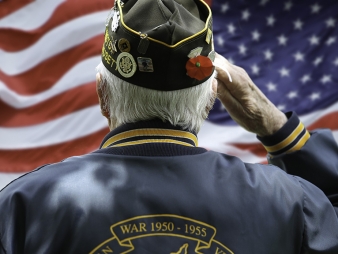Children with aging parents often find themselves in the difficult position of placing their mother or father in an assisted living or long term care environment with little knowledge of their parent’s financial situation. The children are juggling their parent’s health against the difficult decision of “how do I pay for this care?”
The three basic options for payment of care are: self-pay or paying from the parent’s resources; applying for Medicaid; or a combination of paying from the available resources using Aid and Attendance through the Department of Veterans Affairs.
In the initial interview to assist with long term care, our specialists will always ask the question, “Was your mother or father a veteran?” The response is generally, “What difference does that make? They are not presently receiving veteran’s benefits.” The children are often surprised to learn their parent did not have to be injured to receive Aid and Attendance through the Department of Veteran’s Affairs (VA), and the surviving spouse of an honorably discharged veteran (or those having been discharged other than dishonorably) may also be entitled to a similar benefit even if the surviving spouse never served.
The basic eligibility requirements are:
Service
A minimum of 90 days of active service (full time) with a minimum of 1 day served during a period of war. For those who were on active duty after September, 7, 1980, there is an additional service requirement of a minimum of 24 months, and if the veteran served less than this amount of time, he/she must have finished an entire tour of duty, which is his or her period of obligated active duty service.
War time periods are:
Mexican Border Period – May 9, 1916 through April 5, 1917
WWI – April 6, 1917 through November 11, 1918
WWII – December 7, 1941 through December 31, 1946
Korean Conflict – June 27, 1950 through January 31, 1955
Vietnam era – February 28, 1961 through May 7, 1975 for Veterans who served in the Republic of Vietnam during that period; otherwise August 5, 1964 – May 7, 1975
Gulf War – August 2, 1990, to a date to be determined
Net Worth Requirements for 2019 and 2020
For 2019, the net worth requirement is $127,061. For 2020, it is estimated to be $129,094. Net worth does not include the residence, automobile, or personal items.
The look back period is three years, and this is waived with no penalty period if the gift or improper transfer is returned.
Income of the veteran and their spouse is added as a resource. Thus, if a veteran receives $1000 a month in income in social security, this will add to their available resources. It is prudent to consult with an attorney familiar with the Veterans Affairs’ requirements and federal Medicaid requirements. Medicaid requirements and VA requirements are different in look-back periods and application. A mistake in planning could result in substantial penalties under either program. Proper planning will assist in creating eligibility.
Age & Attendance Requirements
The Age & Attendance requirements apply to the veteran or the survivor/spouse, who must meet ONE of the conditions below:
Needs assistance with Activities of Daily Living (ADLs) such as bathing, grooming, dressing, eating, and mobility; or (this applies to assisted living facilities)
Be bedridden; or
Be a resident of a nursing home facility due to the inability to function physically or mentally; or
Have profound visual impairment (both eyes have equal or lesser than 5/200 visual acuity, or the visual field has concentric contraction equal to 5 degrees or less).
Maximum Benefit
For 2019, the maximum annual benefit for a single veteran with no dependents is $22,577; the maximum benefit for a married veteran with no dependents is $26,766; and the maximum benefit for a surviving spouse with no dependents is $14,509.
Countable Annual Income
There is a maximum countable income for the program. This is called the Maximum Annual Pension Rate (MAPR). This rate is different for veterans and surviving spouses. The income is reduced after a 5% medical threshold by the cost of unreimbursed medical expenses incurred. The VA supplies a table for this calculation. However, it is wise to seek experienced legal counsel to assist in the determination of applicable expenses before submitting the application to the VA.
Summary
The Aid & Attendance benefit is an often overlooked benefit for our clients, particularly those in an assisted living environment. Filing an application without legal assistance could result in failure to receive valuable benefits available to the veteran or their surviving spouse. If you need further information you should contact: Nicole Hawks (419) 289-6888; Ann Salek (330) 723-6404; or Kim Rose (740) 397-4040. Both Kim and Nicole are certified Veteran’s Affairs attorneys. Ann is a Certified Elder Law Attorney (CELA) and an Ohio State Bar Association Certified Specialist in Estate Planning, Trust and Probate Law.
*Kim served as Judge Advocate General in the United States Army Reserve.
Tagged In:Aid and AttendanceVAVeteran Benefits








